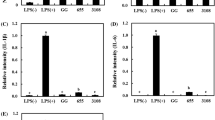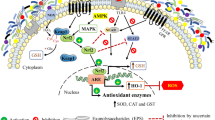Abstract
Lactobacillus plantarum MA2 was isolated from traditional Chinese Tibet kefir grains, which possess several excellent properties and functions. We previously demonstrated the antioxidant activities of this bacterium in vitro. However, the maintenance and survival of L. plantarum MA2 inside the murine intestinal tract, where it exerts its probiotic properties, and whether its effects are elicited directly on the host remain unknown. Therefore, this study investigated the mechanisms of L. plantarum MA2 in aging mice following d-galactose administration. The levels of malondialdehyde decreased significantly in the L. plantarum MA2 groups after oral ingestion compared to the d-galactose model group, and total antioxidant capacity and glutathione peroxidase and superoxide dismutase activities increased significantly in the serum and liver. We combined fluorescein isothiocyanate labeling and green fluorescent protein expression to dynamically monitor the colonization and distribution of L. plantarum MA2 in the murine intestinal tract. The results indicated that L. plantarum MA2 was detected in the ileum, colon, and feces after single and continuous oral administration at day 21 and was maintained at 104–105 CFU/g. These results suggest that L. plantarum MA2 colonizes and survives in the murine intestinal tract to exert its antioxidative effects.





Similar content being viewed by others
References
Anderson RC, Cookson AL, McNabb WC, Park Z, McCann MJ, Kelly WJ, Roy NC (2010a) Lactobacillus plantarum MB452 enhances the function of the intestinal barrier by increasing the expression levels of genes involved in tight junction formation. BMC Microbiol 10:316
Anderson RC, Cookson AL, McNabb WC, Kelly WJ, Roy NC (2010b) Lactobacillus plantarum DSM 2648 is a potential probiotic that enhances intestinal barrier function. FEMS Microbiol Lett 309:184–192
Barc MC, Charrin-Sarnel C, Rochet V, Bourlioux F, Sandré C, Boureau H, Doré J, Collignon A (2008) Molecular analysis of the digestive microbiota in a gnotobiotic mouse model during antibiotic treatment: influence of Saccharomyces boulardii. Anaerobe 14:229–233
Bhushan Kumar R, Eiichi T, Frangioni John V (2007) Synthesis of conjugatable bisphosphonates for molecular imaging of large animals. Angew Chem Int Edit 46:7969–7971
Coombes JL, Robey EA (2010) Dynamic imaging of host-pathogen interactions in vivo. Nat Rev Immunol 10:353–364
Cunninghamrundles S, Ahmé S, Bengmark S, Johannliang R, Marshall F, Metakis L, Califano C, Dunn AM, Grassey C, Hinds G, Cervia J (2008) Iconography: probiotics and immune response. Econ Bull 7:1–9
Daly MJ, Gaidamakova EK, Matrosova VY, Vasilenko A, Zhai M, Venkateswaran A, Hess M, Omelchenko MV, Kostandarithes HM, Makarova KS, Wackett LP, Fredrickson JK, Ghosal D (2004) Accumulation of Mn(II) in Deinococcus radiodurans facilitates gamma-radiation resistance. Science 306:1025–1028
de Vries MC, Vaughan EE, Kleerebezem M, de Vos WM (2006) Lactobacillus plantarum survival, functional and potential probiotic properties in the human intestinal tract. Int Dairy J 16:1018–1028
Esposito LA, Kokoszka JE, Waymire KG, Cottrell B, MacGregor GR, Wallace DC (2000) Mitochondrial oxidative stress in mice lacking the glutathione peroxidase-1 gene. Free Radic Biol Med 28:754–766
Fasseas MK, Fasseas C, Mountzouris KC, Syntichaki P (2013) Effects of Lactobacillus salivarius, Lactobacillus reuteri, and Pediococcus acidilactici on the nematode Caenorhabditis elegans include possible antitumor activity. Appl Microbiol Biot 97:2109–2118
Forsyth CB, Farhadi A, Jakate SM (2009) Lactobacillus GG treatment ameliorates alcohol-induced intestinal oxidative stress, gut leakiness, and liver injury in a rat model of alcoholic steatohepatitis. Alcohol 43:163–172
Fuller R, Gibson GR (1997) Modification of the intestinal microflora using probiotics and prebiotics. Scan J Gastroenterol Suppl 222:28–31
Graul T, Cain AM, Karpa KD (2009) Lactobacillus and bifidobacteria combinations: a strategy to reduce hospital-acquired Clostridium difficile diarrhea incidence and mortality. Med Hypotheses 73:194–198
Han YT, Han AW, Yu GY, Wang YJ, Cui RY, Wang CB (2004) Inhibitory effect of polypeptide from Chlamys farreri on ultraviolet A-induced oxidative damage on human skin fibroblasts in vitro. Pharmacol Res 49(3):265–274
Hsieh HM, Wu WM, Hu ML (2011) Genistein attenuates D-galactose-induced oxidative damage through decreased reactive oxygen species and NF-κB binding activity in neuronal PC12 cells. Life Sci 88:82–88
Jones RM, Mercante JW, Neish AS (2012) Reactive oxygen production induced by the gut microbiota: pharmacotherapeutic implications. Curr Med Chem 19:1519–1529
Kaizu H, Sasaki M, Nakajima H, Suzuki Y (1993) Effect of antioxidative lactic acid bacteria on rats fed a diet deficient in vitamin E. J Dairy Sci 76:2493–2499
Kimoto-Nira H, Ohmomo S, Nomura M, Kobayashi M, Mizumahi K, Okamoto T (2008) Interference of in vitro and in vivo growth of several intestinal bacteria by Lactococcus strains. J Microbiol Biotechn 18(7):1286–1289
Kobayashi H, Ogawa M, Alford R, Choyke PL, Urano Y (2010) New strategies for fluorescent probe design in medical diagnostic imaging. Chem Rev 110:2620–2640
Kullisaar T, Zilmer M, Mikelsaar M, Vihalemm T, Annuk H, Kairanc C, Kilk A (2002) Two antioxidative lactobacilli strains as promising probiotics. Int J Food Microbiol 72(3):215–224
Larrainzar E, O’Gara F, Morrissey JP (2005) Applications of autofluorescent proteins for in situ studies in microbial ecology. Annu Rev Microbiol 59:257–277
Li Y, Huang TT, Carlson EJ, Melov S, Ursell PC, Olson JL, Noble LJ, Yoshimura MP, Berger C, Chan PH, Wallace DC, Epstein CJ (1995) Dilated cardiomyopathy and neonatal lethality in mutant mice lacking manganese superoxide dismutase. Nat Genet 11:376–381
Li SY, Zhao YJ, Zhang L, Zhang X, Huang L, Li D, Niu CH, Yang ZN, Wang Q (2012) Antioxidant activity of Lactobacillus plantarum strains isolated from traditional Chinese fermented foods. Food Chem 135:1914–1919
Lick S, Drescher K, Heller KJ (2001) Survival of Lactobacillus delbrueckii subsp. bulgaricus and Streptococcus thermophilus in the terminal ileum of fistulated Gottingen minipigs. Appl Environ Microb 67(9):4137–4143
Luo D, Fang B (2008) Structural identification of ginseng polysaccharides and testing of their antioxidant activities. Carbohyd Polym 72(3):376–381
Maré L, Wolfaardt GM, Dicks LM (2006) Adhesion of Lactobacillus plantarum 423 and Lactobacillus salivarius 241 to the intestinal tract of piglets, as recorded with fluorescent in situ hybridization (FISH), and production of plantaricin 423 by cells colonized to the ileum. J Appl Microbiol 100:838–845
Martarelli D, Verdenelli MC, Scuri S, Cocchioni M, Silvi S, Cecchini C, Pompei P (2011) Effect of a probiotic intake on oxidant and antioxidant parameters in plasma of athletes during intense exercise training. Curr Microbiol 62:1689–1696
Mikelsaar M, Zilmer M (2009) Lactobacillus fermentum ME-3 - an antimicrobial and antioxidative probiotic. Microb Ecol Health Dis 21(1):1–27
Minic R, Gavrovic-Jankulovic M, Petrusic V, Zivkovic I, Eijsink VG, Dimitrijevic L, Mathiesen G (2015) Effects of orally applied Fes p1-displaying L. plantarum WCFS1 on Fes p1 induced allergy in mice. J Biotechnol 199:23–28
Mitsuoka T (2000) Significance of dietary modulation of intestinal flora and intestinal environment. Biosci Microbiota, Food Health 19(1):15–25
Parodi PW (2003) The role of intestinal bacteria in the cause and prevention of cancer: modulation through diet and probiotics. Latte
Patel R, Dupont HL (1996) New approaches for bacteriotherapy: prebiotics, new-generation probiotics, and synbiotics. J Biogeogr 23:283–293
Paturi G, Phillips M, Jones M, Kailasapathy K (2006) Immune enhancing effects of Lactobacillus acidophilus LAFTI L10 and Lactobacillus paracasei LAFTI L26 in mice. Int J Food Microbiol 115:115–118
Pavan S, Desreumaux P, Mercenier A (2003) Use of mouse models to evaluate the persistence, safety, and immune modulation capacities of lactic acid bacteria. Clin Diagn Lab Immun 10(4):696–701
Persichetti E, Michele AD, Codini M, Traina G (2014) Antioxidative capacity of Lactobacillus fermentum LF31 evaluated in vitro by oxygen radical absorbance capacity assay. Nutrition 30:936–938
Peuhkuri K, Lähteenmäki T, Sievi E, Saxelin M, Vapaatalo H, Korpela R (1996) Antioxidative properties of Lactobacillus GG measured as prostacyclin and nitric oxide production in endothelial cell culture. Nutr Today 31:53–54
Smith PK, Krohn RI, Hermanson GT, Mallia AK, Gartner FH, Provenzano MD, Fujimoto EK, Goeke NM, Olson BJ, Klenk DC (1985) Measurement of protein using bicinchoninic acid. Anal Biochem 150:76–85
Songisepp E (2005) Evaluation of technological and functional properties of the new probiotic Lactobacillus fermentum ME-3. Diss Med Univ Tartuensis
Songisepp E, Kullisaar T, Hutt P, Elias P, Brilene T, Zilmer M, Mikelsaar M (2004) A new probiotic cheese with antioxidative and antimicrobial activity. J Dairy Sci 87(7):2017–2023
Takeshita F, Takahashi RU, Onodera J, Ochiya T (2012) In vivo imaging of oligonucleotide delivery. Methods Mol Biol 872:243–253
Uhrbom L, Nerio E, Holland EC (2004) Dissecting tumor maintenance requirements using bioluminescence imaging of cell proliferation in a mouse glioma model. Nat Med 10(11):1257–1260
Vesa T, Pochart P, Marteau P (2000) Pharmacokinetics of Lactobacillus plantarum NCIMB 8826, Lactobacillus fermentum KLD, and Lactococcus lactis MG 1363 in the human gastrointestinal tract. Aliment Pharm Therap 14(6):823–828
Wang YP, Xu N, Xi AD, Ahmed Z, Zhang B, Bai XJ (2009a) Effects of Lactobacillus plantarum MA2 isolated from Tibet kefir on lipid metabolism and intestinal microflora of rats fed on high-cholesterol diet. Appl Microbiol Biot 84:341–347
Wang AN, Yi XW, Yu HF, Dong B, Qiao SY (2009b) Free radical scavenging activity of Lactobacillus fermentum in vitro and its antioxidative effect on growing-finishing pigs. J Appl Microbiol 107:1140–1148
Wang B, Li JS, Li QR, Zhang HY, Li N (2009c) Isolation of adhesive strains and evaluation of the colonization and immune response by Lactobacillus plantarum L2 in the rat gastrointestinal tract. Int J Food Microbiol 132:59–66
Wang YP, Wang JR, Dai WL (2011) Use of GFP to trace the colonization of Lactococcus lactis WH-C1 in the gastrointestinal tract of mice. J Microbiol Meth 86:390–392
Xu N, Wang YP, Xi AD, Li C (2009) Identification of lactic acid bacteria MA2 strain from kefir grains and effect on rat intestinal flora. J Tianjin Univ Sci Technol 24:1–5
Yang TS, Sun Y, Liu Q, Feng W, Yang PY, Li FY (2012) Cubic sub-20 nm NaLuF4-based upconversion nanophosphors for high-contrast bioimaging in different animal species. Biomaterials 33:3733–3742
Yu HF, Wang AN, Li XJ, Qiao SY (2008) Effect of viable Lactobacillus fermentum on the growth performance, nutrient digestibility and immunity of weaned pigs. J Anim Feed Sci 17(1):61–69
Zhai OX, Wang G, Zhao JX, Liu XM, Tian FW, Zhang H, Chen W (2013) Protective effects of Lactobacillus plantarum CCFM8610 against acute cadmium toxicity in Mice. Appl Environ Microb 79(5):1508–1515
Zhang SW, LÜ JP, Menghe B, Liu L, Hu XB (2010a) Antioxidative activity of Lactobacillus casei subsp. casei SY13 on ageing model mice. Sci Agric Sin 43(10):2141–2146
Zhang JW, Du P, Chen DW, Cui L, Ying CM (2010b) Effect of viable Bifidobacterium supplement on the immune status and inflammatory response in patients undergoing resection for colorectal cancer. Zhonghua wei chang wai ke za zhi =. Chin J Gastrointest Surg 13:40–43
Zhang Y, Du RT, Wang LF, Zhang HP (2010c) The antioxidative effects of probiotic Lactobacillus casei Zhang on the hyperlipidemic rats. Eur Food Res Technol 231(1):151–158
Zhou JY, Prognon P (2006) Raw material enzymatic activity determination: a specific case for validation and comparison of analytical methods—the example of superoxide dismutase (SOD). J Pharmaceut Biomed 40:1143–1148
Acknowledgments
This study was financially supported by the National Natural Science Foundation of China (31171629) and the National Natural Science Foundation of China (31401677).
Author information
Authors and Affiliations
Corresponding author
Ethics declarations
All applicable international, national, and/or institutional guidelines for the care and use of animals were followed.
Conflict of interest
The authors declare that they have no competing interests.
Rights and permissions
About this article
Cite this article
Tang, W., Xing, Z., Hu, W. et al. Antioxidative effects in vivo and colonization of Lactobacillus plantarum MA2 in the murine intestinal tract. Appl Microbiol Biotechnol 100, 7193–7202 (2016). https://doi.org/10.1007/s00253-016-7581-x
Received:
Revised:
Accepted:
Published:
Issue Date:
DOI: https://doi.org/10.1007/s00253-016-7581-x




